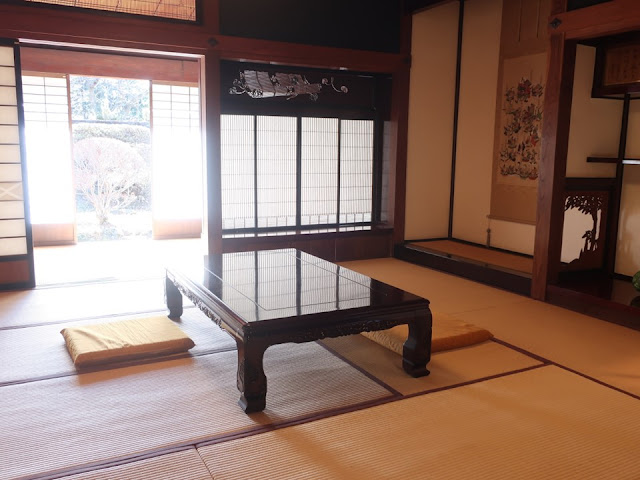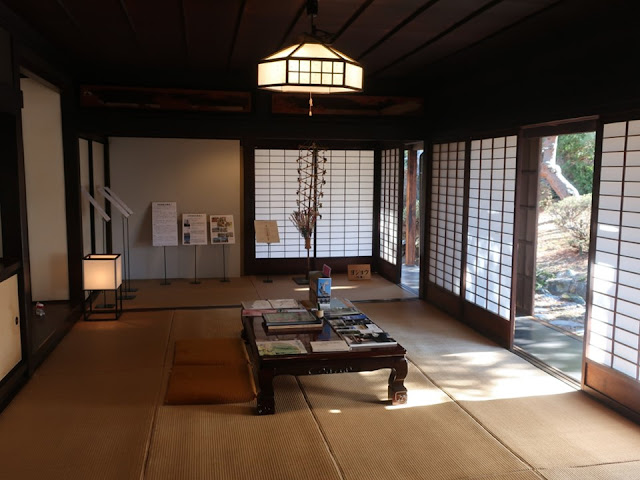Baba family served a famous warlord (Takeda clan) in the medieval era. After the destruction of the warlord, Baba family moved to Matsumoto and became a powerful farmer. During the Edo period (1603~1868), the lord (daimyo) visited the family. The residence was built in the late 19th century, and was donated to Matsumoto city recently. It was a residence of a wealthy, so it was out of the scope of my blog (fun of good ordinary Japanese). But I’d like to show you the house together with the local festival.
武田家の滅亡とともに松本市内田に住みついたといわれる馬場氏の邸宅です。江戸時代には藩主が訪れたほどの名家です。江戸末期に建てられた屋敷の主屋等が松本市に寄贈されました。これは本ブログのテーマの人々の楽しみとはいえないのですが、内田地区で行われている庶民の正月の行事「御柱」とともに見学しました。
The residence is behind the earthwork.
土塁の向こう側が馬場家住宅です。
The main gate is so dignified. 表門は威圧感があります。
We can see Matsumoto basin and north Japan Alps on the opposite side.
振り返ると松本平の先に北アルプスが見えます。
In side the gate, there is a main building which has the large roof ornament “Suzume(swallow) odoshi(threat)”. The residences of distinguished families in the region (south-west of Nagano prefecture) often have the ornament on it. The gate on the right was opened only while visiting of the lord in the Edo period.
門をくぐると主屋があります。「雀おどし」とよばれる棟飾りがついています。長野県西南部の旧家に見られる建物です。右側が中門で、諏訪高島藩主の来訪時だけ使われたようです。
The floor plan is typical one among the residences of distinguished families. A living room is in center, and the room at its right was the one to welcome ordinary customers.
レイアウトは本棟造りに共通する間取りだそうです。中央に「おえ」とよぶ15畳の部屋は居間、隣りの「かみおえ」とよぶ部屋は日常の客を迎える場所として使われていたと考えられています。
The view of the living room from the guest entrance.
玄関から見た「おえ」
The room next to the entrance was used to welcome important guests such as a lord.
玄関の隣の座敷は、藩主など特別な人を接客する場所です。
The special toilet and bathroom for special guests are next to the room.
座敷の玄関側に、特別な客用のトイレと湯殿があります。
The room facing the garden is regarded as the study of the owner. There were exhibits of a local festival at innermost.
縁側に沿った小座敷は、当主の部屋と考えられています。訪問時は、内田地区の御柱がパネルと模型で紹介されていました。
The view from the entrance for family members; it was a private area. They gathered around the irori fireplace.
土間から勝手を見たところです。日常の生活空間ですね。人が集まる囲炉裏があります。
There is a storage for vegetables near the entrance door.
勝手口の前には、野菜を保管する石室のような設備があります。
The second floor in front is considered as a bedroom for servants.
気になる表二階は、奉公人の寝室と考えられています。
There is a house for a retired owner and a tea room behind the main building. Baba family owns there even now, so it is an exclusion zone.
主屋の奥には隠居屋と茶室があります。今も馬場家のプライベート空間で、立入禁止です。
The residence above is near Baba’s one; those structures are similar. I have an acquaintance who has a resemble house. He said the building was too large for a nuclear family to live. He added it was drafty so it got cold soon. He doesn’t live in the ancestral house, so it is vacant now.
However, it is a fun time to chat around the fireplace. Even in a small condo in Japan such as 80㎡ (Gross Floor Area), a large living room is popular. It is a crucial space for a family to talk with guests like relatives.
近くに建つこちらのお宅、構造は馬場家住宅に似ていますね。同様の家を所有する知人は、「奉公人を置かず核家族化が進む今となっては広すぎるし寒いので使っていない」と言っていました。
しかし、大勢で囲炉裏を囲むのは楽しい時間。マンションでも二間続きの広いリビングルームが人気なのも分かりますね。
Local festival (Onbe festival)、御柱(おんべ祭り)
People set a pole beside a dosojin deity (stone statue) in the mid-January, and pray for a rich harvest and sound health. They remove the pole around ten days later, and bring the attached ornaments to their home; those are charms.
小正月に道祖神の横に飾り柱を立てて、五穀豊穣や無病息災などを祈ります。柱は10日ほどで倒され、飾りは御守として各家が持ち帰ります。
Dosojin deity is at the edge of the village, and prevents disaster from invading the village.
道祖神は集落の外れに置かれ、災厄が入ってくるのを防ぎます。内田地区横山の御柱。
These are a dosojin deity and a pole in a neighboring village. People make ornaments of the pole together. Traditional events such as a dance are held in this area; modern events such as a sports day are also held. Those are good chances to strengthen a tie of a community, I think. Strong bond would be a safety net to prevent dying alone, disaster and so on, wouldn’t it?
こちらは隣の内田地区北花見の御柱。飾り付けは住民の共同作業です。内田地区では、ササラ踊りやお八日念仏といった伝統行事が受け継がれています。また、松本市の他の地区と同様、運動会や文化祭が実施されています。住民の繋がりを強める仕掛けでもあると思います。強い繋がりは孤独死や防災のセイフティーネットですものね。
Visited in January, 2024
Official website: https://matsu-haku.com/babake/ (in
Japanese), accessed in June, 2024
Previous post (ex-inn for women who worked away from home): Matsumoto
City Open-Air Architectural Museum: Inn for female workers、松本市歴史の里・工女宿
Next post (museum in a mountainous area of the same city): Matsumoto city Azumi museum、松本市安曇資料館

















Comments
Post a Comment